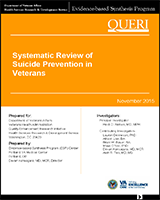NCBI Bookshelf. A service of the National Library of Medicine, National Institutes of Health.
This systematic review updates evidence on the accuracy of methods to identify individuals at increased risk for suicide, and the efficacy/effectiveness and adverse effects of healthcare service interventions in reducing suicide and other suicidal self-directed violence. Important areas of ongoing research and current evidence gaps on suicide prevention are also addressed. This report includes studies relevant to healthcare services provided to Veterans and military personnel in the United States (US), and updates 3 previous Department of Veterans Affairs (VA) Evidence-based Synthesis Program (ESP) reviews on these topics.
Veterans and military personnel represent 20% of all known suicides in the US. Rates of suicide increased during the wars in Afghanistan and Iraq, and between 2000 and 2010, the suicide rate among Veterans rose higher than the rate among civilians. Female Veterans are at especially high risk relative to other women. These trends have led to new initiatives within the VA and military to address suicide prevention.
During the year prior to suicide, an estimated 77% of individuals make contact with primary care and 32% with mental health care clinicians, providing opportunities for suicide risk assessment and intervention. However, screening for suicide risk in general medical practice is not part of standard care in the US. Efforts to prevent suicide in individuals at high risk, such as those with recent suicide attempts, generally include treatment of underlying conditions and psychotherapy. In addition to individual-level approaches to suicide prevention, initiatives have been implemented at organizational, health system, and community levels. However, despite the existence of many types of services, very few studies demonstrating their efficacy and effectiveness have been published. As a result, their influence on suicide prevention remains unclear.
Contents
- PREFACE
- EXECUTIVE SUMMARY
- INTRODUCTION
- METHODS
- RESULTS
- SEARCH RESULTS
- KEY QUESTION 1 A) What are the accuracy and adverse effects of methods to identify Veterans and military personnel at increased risk for suicide and other suicidal self-directed violence?
B) Does accuracy and adverse effects vary by settings, delivery modes, targeted populations, or other factors? - KEY QUESTION 2 What are the efficacy/effectiveness and adverse effects of suicide prevention interventions in reducing rates of suicide and other suicidal self-directed violence in Veterans and military personnel? Interventions include healthcare services directed towards A) populations and B) individuals
- KEY QUESTION 3 What are important areas of ongoing research and current evidence gaps in research on suicide prevention in Veterans and military personnel, and how could they be addressed by future research?
- SUMMARY AND DISCUSSION
- REFERENCES
- APPENDIX A SEARCH STRATEGIES
- APPENDIX B STUDY SELECTION
- APPENDIX C CRITERIA USED IN QUALITY ASSESSMENT
- APPENDIX D PEER REVIEW COMMENTS/AUTHOR RESPONSES
- APPENDIX E EXCLUDED REFERENCES
Prepared for: Department of Veterans Affairs, Veterans Health Administration, Quality Enhancement Research Initiative, Health Services Research & Development Service, Washington, DC 20420. Prepared by: Evidence-based Synthesis Program (ESP) Center, Portland VA Medical Center, Portland, OR, Devan Kansagara, MD, MCR, Director.
Suggested citation:
Helson H, Denneson L, Low A, Bauer B, O’Neil M, Kansagara D, Teo A. Systematic Review of Suicide Prevention in Veterans. VA ESP Project #05-225; 2015.
This report is based on research conducted by the Evidence-based Synthesis Program (ESP) Center located at the Portland VA Health Care System, Portland, OR, funded by the Department of Veterans Affairs, Veterans Health Administration, Office of Research and Development, Quality Enhancement Research Initiative. The findings and conclusions in this document are those of the author(s) who are responsible for its contents; the findings and conclusions do not necessarily represent the views of the Department of Veterans Affairs or the United States government. Therefore, no statement in this article should be construed as an official position of the Department of Veterans Affairs. No investigators have any affiliations or financial involvement (eg, employment, consultancies, honoraria, stock ownership or options, expert testimony, grants or patents received or pending, or royalties) that conflict with material presented in the report.
- NLM CatalogRelated NLM Catalog Entries
- Review Suicide Prevention Interventions and Referral/Follow-Up Services: A Systematic Review[ 2012]Review Suicide Prevention Interventions and Referral/Follow-Up Services: A Systematic ReviewO'Neil ME, Peterson K, Low A, Carson S, Denneson LM, Haney E, Shiroma P, Kansagara D. 2012 Mar
- Combat duty in Iraq and Afghanistan, mental health problems and barriers to care.[US Army Med Dep J. 2008]Combat duty in Iraq and Afghanistan, mental health problems and barriers to care.Hoge CW, Castro CA, Messer SC, McGurk D, Cotting DI, Koffman RL. US Army Med Dep J. 2008 Jul-Sep; :7-17.
- Suicide risk in Iraq and Afghanistan veterans with mental health problems in VA care.[J Psychiatr Res. 2015]Suicide risk in Iraq and Afghanistan veterans with mental health problems in VA care.Maguen S, Madden E, Cohen BE, Bertenthal D, Neylan TC, Seal KH. J Psychiatr Res. 2015 Sep; 68:120-4. Epub 2015 Jun 25.
- Suicide attempts before joining the military increase risk for suicide attempts and severity of suicidal ideation among military personnel and veterans.[Compr Psychiatry. 2014]Suicide attempts before joining the military increase risk for suicide attempts and severity of suicidal ideation among military personnel and veterans.Bryan CJ, Bryan AO, Ray-Sannerud BN, Etienne N, Morrow CE. Compr Psychiatry. 2014 Apr; 55(3):534-41. Epub 2013 Oct 22.
- Review Treatment for Posttraumatic Stress Disorder in Military and Veteran Populations: Final Assessment[ 2014]Review Treatment for Posttraumatic Stress Disorder in Military and Veteran Populations: Final AssessmentCommittee on the Assessment of Ongoing Efforts in the Treatment of Posttraumatic Stress Disorder, Board on the Health of Select Populations, Institute of Medicine. 2014 Jun 17
- Systematic Review of Suicide Prevention in VeteransSystematic Review of Suicide Prevention in Veterans
Your browsing activity is empty.
Activity recording is turned off.
See more...
